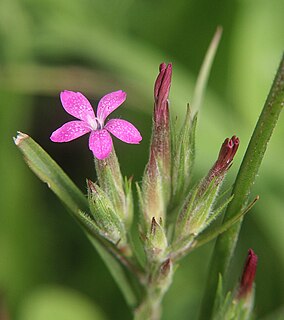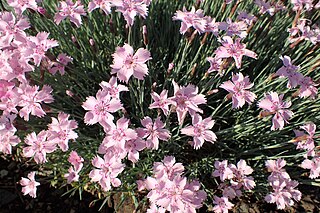
Dianthus caryophyllus, commonly known as the carnation or clove pink, is a species of Dianthus. It is probably native to the Mediterranean region but its exact range is unknown due to extensive cultivation for the last 2,000 years.

Dianthus is a genus of about 300 species of flowering plants in the family Caryophyllaceae, native mainly to Europe and Asia, with a few species in north Africa and in southern Africa, and one species in arctic North America. Common names include carnation, pink and sweet william.
João Rodrigues de Castelo Branco, better known as Amato Lusitano and Amatus Lusitanus (1511–1568), was a notable Portuguese Jewish physician of the 16th century. Like Herophilus, Galen, Ibn al-Nafis, Michael Servetus, Realdo Colombo and William Harvey, he is credited as making a discovery in the circulation of the blood. He is said to have discovered the function of the valves in the circulation of the blood.

Dianthus barbatus, the sweet William, is a species of flowering plant in the family Caryophyllaceae, native to southern Europe and parts of Asia. It has become a popular ornamental garden plant. It is a herbaceous biennial or short-lived perennial plant growing to 13–92 cm tall, with flowers in a dense cluster of up to 30 at the top of the stems. Each flower is 2–3 cm diameter with five petals displaying serrated edges. Wild plants produce red flowers with a white base, but colours in cultivars range from white, pink, red, and purple to variegated patterns. The exact origin of its English common name is unknown but first appears in 1596 in botanist John Gerard's garden catalogue. The flowers are edible and may have medicinal properties. Sweet William attracts bees, birds, and butterflies.

Dianthus armeria, the Deptford pink or grass pink, is a species of Dianthus ("pink") native to most of Europe, from Portugal north to southern Scotland and southern Finland, and east to Ukraine and the Caucasus. It is naturalised in North America.

Dianthus gratianopolitanus, commonly known as the Cheddar pink or clove pink, is a species of plant in the family Caryophyllaceae. It is a herbaceous perennial, hardy to zones 4–8. It grows to a height of 0.5 to 1 feet, blooming from May to June. Flowers are fragrant and rose pink. Grows best in full sun, and has medium water requirements. Overwatering or poor drainage leads to crown rot, and plants do not tolerate wet winter soil conditions.

Dianthus superbus, the fringed pink or large pink, is a species of Dianthus native to Europe and northern Asia, from northernmost Spain and France north to arctic Norway, and east to Japan; in the south of its range, it occurs at high altitudes, up to 2,400 m.

The pink lanternshark is a shark of the family Etmopteridae found around Australia and New Caledonia, at depths of between 110 and 880 m. Its length is up to 41 cm.
Castelo Branco is Portuguese for white castle, and may refer to:

Norah Lindsay was a socialite garden designer who between the World wars became a major influence on garden design and planting in the United Kingdom and on the Continent.

HMS Dianthus was a Flower-class corvette of the Royal Navy. She was launched on 9 July 1940 from the Leith Docks on the Firth of Forth and named after the genus of flowering plants including Carnation, Pink, and Sweet William. The ship escorted trade convoys between Newfoundland and the Western Approaches through the Battle of the Atlantic wolf pack attacks of the winter of 1942–43.
German submarine U-379 was a Type VIIC U-boat built for Nazi Germany's Kriegsmarine for service during World War II. She was laid down on 27 May 1940 by Howaldtswerke, Kiel as yard number 10, launched on 15 October 1941 and commissioned on 29 November 1941 under Kapitänleutnant Paul-Hugo Kettner.
Streptomyces lusitanus is a bacterium species from the genus of Streptomyces which has been isolated from soil. Streptomyces lusitanus produces 7-chlortetracycline, naphthyridinomycin, cyanocycline B, N-desmethylnaphthyridinomycin and tetracycline.

Dianthus libanotis, the Mount Libanus pink or Lebanon pink, is a herbaceous perennial plant of the family Caryophyllaceae.

Dianthus plumarius, also known as the common pink, garden pink, or wild pink, is a species of pink-coloured flower in the family Caryophyllaceae.
Pseudokineococcus lusitanus is a Gram-positive, coccus-shaped and motile bacterium from the genus of Pseudokineococcus which has been isolated from a roof tile from Oporto in Portugal.

Flowers in a Crystal Vase is an 1882 painting by Édouard Manet, in the Musée d'Orsay since 1986. It shows clematis and 'oeillets', a French word used for several kinds of cut flowers, many from the Dianthus genus. It was probably produced in July 1882 at Rueil and forms part of a set of still life paintings produced by Manet at the end of his life, mainly showing flowers.

Digitalis mariana is a flowering plant species in the family Plantaginaceae. It is a perennial foxglove with evergreen foliage and rose-red coloured flowers produced in summer. It is native to Portugal and Spain.














